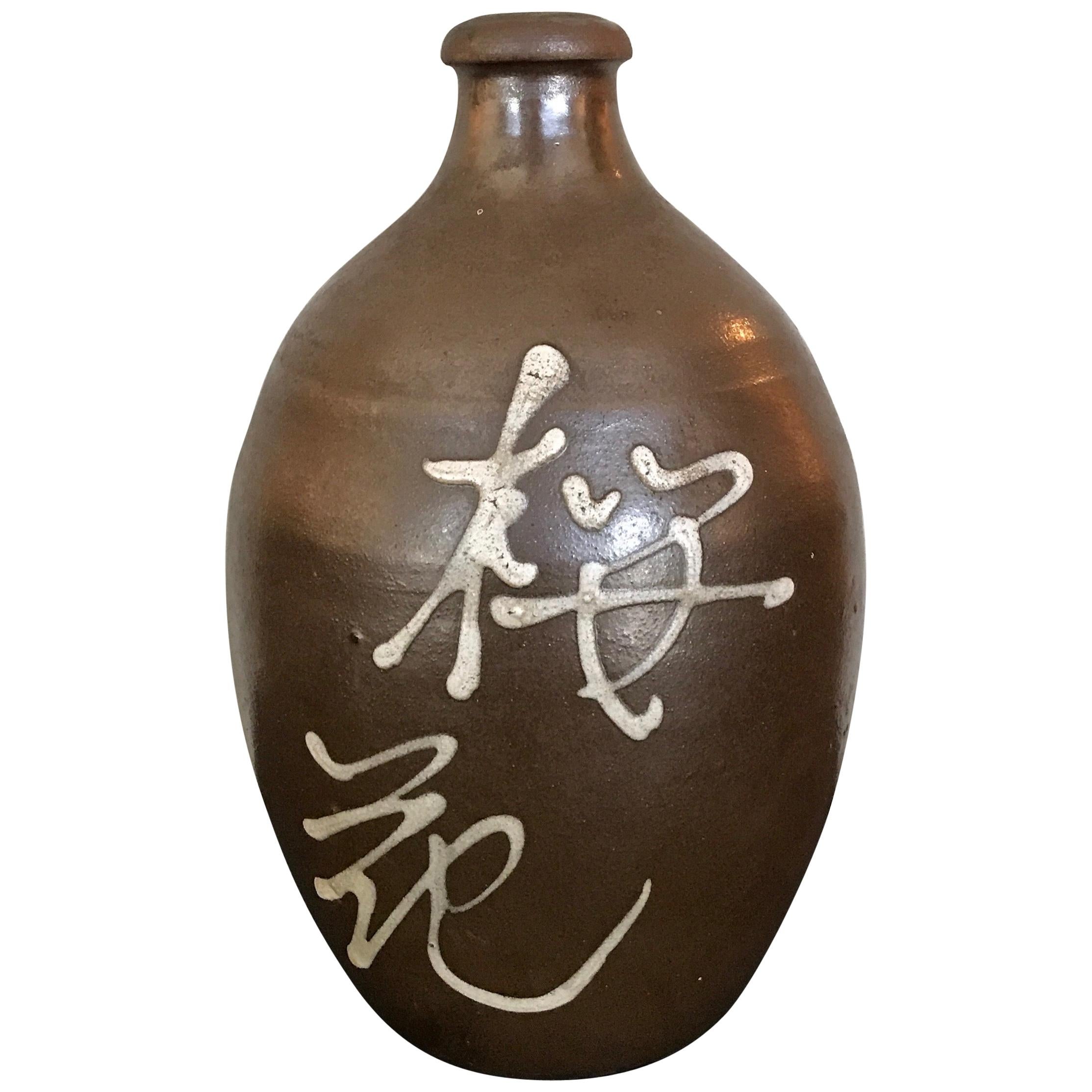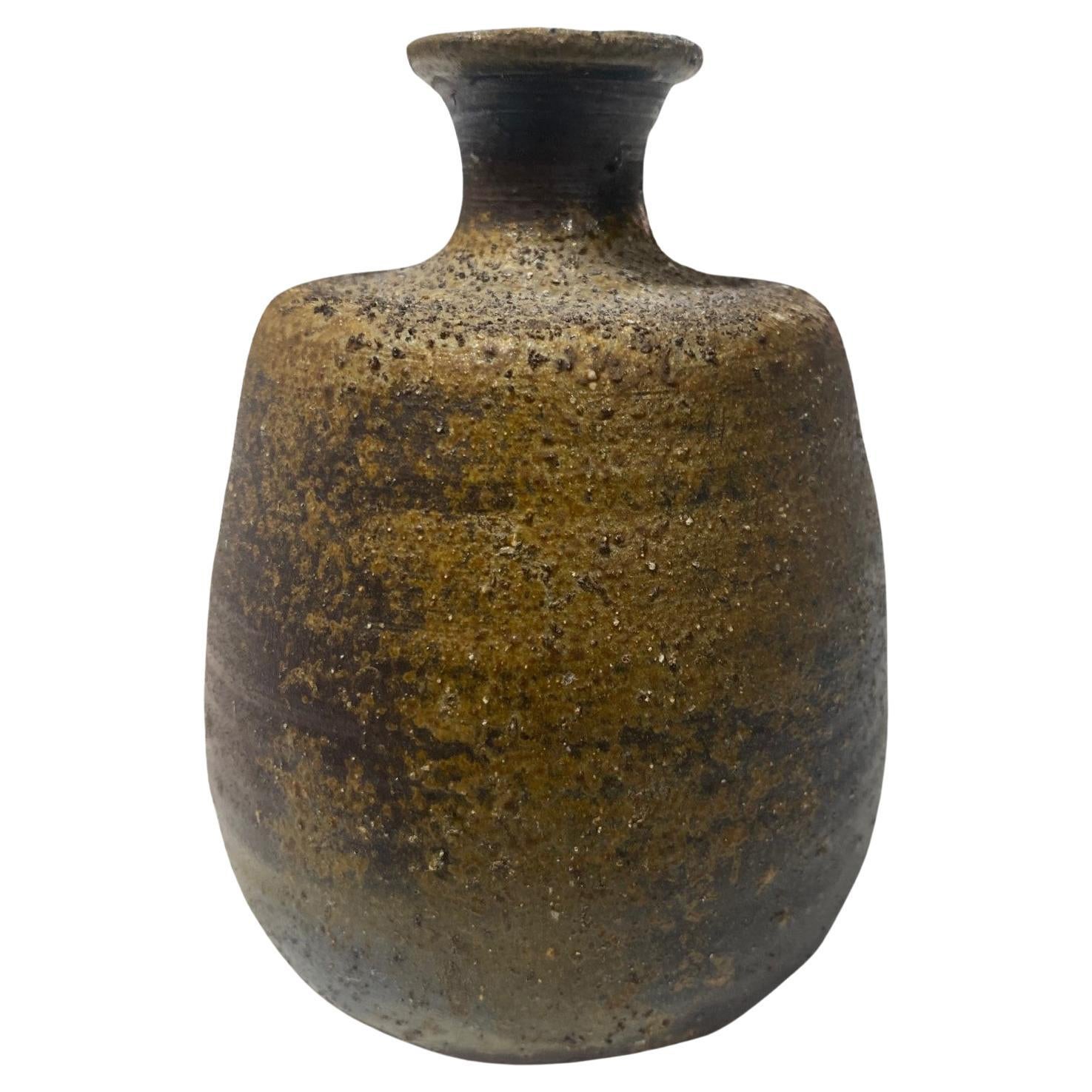Items Similar to Japanese Ceramic Sake Bottle Chosen Karatsu Ware
Want more images or videos?
Request additional images or videos from the seller
1 of 12
Japanese Ceramic Sake Bottle Chosen Karatsu Ware
About the Item
The long neck bottle of classic form was heavily potted with coarse clay with high iron content. The flask, circa 18th century Edo period, was purposed for sake storage but also substituted as a flower vase during tea ceremony. The surface is covered in glossy black glaze and contrasts strikingly with white ash glaze around the shoulder. The white, fired with straw, displays a splashing feather effect and fine crackles, blending in with the black artistically. This type of Karatsu ware was originally introduced by Korean potters who were forcefully brought to Japan after the invasion of Korea at the end of 16th century. They originally settled in Naeshirogawa and Tateno area (nowadays Satsuam) and kick-started the local pottery industry. Their techniques and aesthetics spread across Japan and left strong imprints on Japanese ceramics.
This sub-type Karatsu ware is such an example, known as Chosen or Korean Karatsu. On the base of the bottle, there are two old stickers. One shows the price in BP (British Pounds). The other states that the bottle is a black satsuma from Naeshirogawa circa 18th century. Our research contradicts this acclaimed origin and identifies the flask as being a Chosen Karatsu type. There is, however, strong artistic link between black satsuma ware and chosen karatsu as mentioned above because both were derived from Korean prototypes.
Reference: The Golden Age of Karatsu Stoneware by Francois Villemin. Page 74 and 159.
For a very similar piece see A New Yorker's view of the world: The John C Weber Collection. Cat no. 87 on page 256.
- Dimensions:Height: 10.6 in (26.93 cm)Diameter: 7 in (17.78 cm)
- Style:Japonisme (Of the Period)
- Materials and Techniques:
- Place of Origin:
- Period:
- Date of Manufacture:18th Century
- Condition:Wear consistent with age and use. Light surface wear with a couple of minute flakes on the glaze. Patina on the base.
- Seller Location:Atlanta, GA
- Reference Number:1stDibs: LU945016196382
About the Seller
5.0
Platinum Seller
These expertly vetted sellers are 1stDibs' most experienced sellers and are rated highest by our customers.
Established in 2006
1stDibs seller since 2010
486 sales on 1stDibs
Typical response time: <1 hour
- ShippingRetrieving quote...Ships From: Atlanta, GA
- Return PolicyThis item cannot be returned.
More From This SellerView All
- Collection of Four Japanese Tamba Tokkuri Sake BottlesLocated in Atlanta, GAA set of four Japanese Ceramic Tokkuri Sake storage bottles circa early 20th century (Meiji to Taisho period). The bottles were made in Tamba (Tanba) kil...Category
Early 20th Century Japanese Japonisme Ceramics
MaterialsCeramic
- Japanese Ceramic Ikebana Vase Bizen Ware Nanba KoyoLocated in Atlanta, GAA tall vintage ceramic vase with handle from Japan (20th century) by Nanba Koyo. Made in the tradition of Bizen ware, the vase has a modern aesthetic with a...Category
20th Century Japanese Japonisme Ceramics
MaterialsCeramic
- Japanese Mishima Ceramic Vase Meiji PeriodLocated in Atlanta, GAA Japanese long neck slender ceramic vase in the style of Mishima, circa 19th century, Meiji period. Mishima pottery was originally imported from three islands in Taiwan and then fro...Category
Antique 19th Century Japanese Japonisme Ceramics
MaterialsCeramic
- Japanese Ceramic Vase by Ito Tozan I Meiji PeriodBy Ito Tozan ILocated in Atlanta, GAThis stoneware vase of a jar form was finely decorated with low relief carving and delicate colored glazes depicting bundles of peony flowers. It was made by Ito Tozan I (1846-1920) circa 1890-1900s in the late Meiji Period. The color pallet was both bold and subtle, with dark green and rusty leaves with golden outlines and white and light yellow peony petals covering much of the surface. Impressed with potter's mark on the base. Examples of two pieces by Ito Tozan I were in the collection of MNAAG (Guimet) Paris. Inventory no. MG 13790 an 13792. A vase with similar shape and decoration techniques is featured as Lot 1340 Fine Japanese Art, 13 Sep 2017 Bonhams New York Tozan Ito I established his ceramic business in Kyoto 1867. His studio made both porcelain and stoneware in a style some considered Satsuma while they retained a sophistication of Kyoto ware...Category
Antique 1890s Japanese Japonisme Ceramics
MaterialsCeramic
- Korean Glazed Ceramic Vase Buncheong Ware Joseon DynastyLocated in Atlanta, GAA small antique Korean Buncheong stoneware vase from early Joseon Dynasty circa 16th century. The vase is of a classic pear form with a waisted neck, a flared mouth and a ringed base...Category
Antique 16th Century Korean Other Ceramics
MaterialsCeramic
- Korean Ceramic Buncheong Ware Tea Bowl Early Joseon DynastyLocated in Atlanta, GAAn antique Korean Buncheong stoneware tea bowl (chawan) from early Joseon Dynasty circa late 15th to early 16th century. The bowl with a short ring base is nearly entirely covered in a white slip except the base (known as sougusuri in Japanese, total glaze). Iron-colored scrolling vines were painted on with quick and deft brush strokes, rendering the bowl a vital and spontaneous appeal. It appears that the bowl was dipped in the white slip instead of being brushed on, observing from the slip pattern left on the rim of the bowl. The bowl shows significant age and evident of use for tea drinking. There are losses of glaze flakes throughout, along the rim and inside the bowl. The flake off the glaze left a dark spot on the rim, exposing the deep colored clay underneath. Inside the bowl, many of the glaze flakes appear more superficial and retains a yellowing color from the tea stains (known as amamori, rain leak). There is a historical crack line on the exterior (surface only) that result in associated small losses of glaze. It appears that the crack line was the result from the kiln firing and gradually the glaze around it started to reduce. The bowl comes with a later wrapping cloth and a wood tomobako box, but they are not original to the piece. This particular type of Buncheong ware was associated with the Hakbong-ri kilns in the sacred Mount Gyeryong Mountains, west of Daejeon city in the Chungcheong province. During early Joseon Dynasty, the emperor decided to reject Buddhism to embrace the Confucianism. As a result, many monks were forced to abandon their religious life and returned to the secular society. The monks in Gyeryong mountains set up the kilns and started to produce this so called "Hakbong-ri" type of Buncheong ware. The production was shorted-lived for only a few decades from late 15th to early 16th century before it turned to porcelain, but the ware made during that period was noted for their fresh and enigmatic appeal with deft iron-paint decoration. Collectors cherish these rare pieces for their vitality and spontaneity often used them on important occasions of chado in Japan and passed down to generation. For a similar bowl, see Catalog 52 illustrated on page 87 of the book "Korean Buncheong Ceramics...Category
Antique 15th Century and Earlier Korean Archaistic Ceramics
MaterialsCeramic
You May Also Like
- Hand Painted Vintage Japanese Sake BottleLocated in New York, NYA beautifully shaped and glazed hand painted Japanese sake bottle with gorgeous calligraphy. A wonderful shelf piece. Japan, circa 1960. CR1006a.Category
Mid-20th Century Japanese Ceramics
MaterialsCeramic
- 1610-1640/Japanese White Porcelain Blue and White Vase/"Imari Ware"/Sake BottleLocated in Sammu-shi, ChibaI bought a very nice vase with white porcelain and blue dye. This is a sake bottle called Imari ware in Japan. Imari ware is a kiln with a long history that began in the 17th cen...Category
Antique Early 17th Century Japanese Edo Bottles
MaterialsPorcelain
- Kaneshige Toyo National Treasure Signed Japanese Bizen Pottery Sake Bottle VaseLocated in Studio City, CAA beautiful, perfectly shaped and balanced antique Bizen ware shibui sake bottle (tokkuri) vase by renowned Japanese master potter/artist Kaneshige Toyo (1896-1967) featuring a unique natural, wonderfully textured organic forming ash glaze. Kaneshige is universally considered to be the founder of modern Bizen pottery. In 1956, Kaneshige was certified as a Living National Treasure (Important Intangible Cultural Heritage) for his work in Bizen Ware pottery/ceramics. Bizen Ware is a type of Japanese pottery traditionally from the Bizen province, presently a part of the Okayama prefecture. It is considered one of the Six Ancient Japanese Kilns (along with Echizen ware, Seto ware, Shigaraki ware, Tamba ware, and Tokoname ware). The piece is signed/ sealed on the base with one of Kaneshige's traditional incised marks. A rather striking and engaging work. One of the best Kaneshige works we have come across. Scarce and hard to find in such an excellent condition. Would be a fantastic addition to any Japanese/Asian pottery or Bizen Ware collection or eye-catching stand-alone work in about any setting. Kaneshige's work can be found in numerous prominent collections and museums including: Aichi Prefectural Ceramic Museum, Seto, Japan Brooklyn Museum, NY Hagi Uragami Museum, Yamaguchi, Japan Honolulu Art Museum, HI Ibaraki Ceramic Art Museum, Kasama, Japan Indiana Art...Category
Mid-20th Century Japanese Showa Ceramics
MaterialsStoneware
- Japanese Meiji Period Early 20th Century Sake Bottle with Brown PatinaLocated in Yonkers, NYAn antique Japanese Meiji period monochrome sake bottle from the early 20th century with concentric lines. Created in Japan during the Meiji dynasty, this sake bottle attracts our at...Category
Early 20th Century Japanese Meiji Bottles
MaterialsCeramic
- Monumental Japanese Sake Vessel, c. 1850Located in Chicago, ILThis elegant, large-scale vessel is a Japanese widemouth stoneware jar (kame) traditionally used for storing water and other liquids. This 19th-century example continues traditional ...Category
Antique Mid-19th Century Japanese Meiji Ceramics
MaterialsPorcelain, Stoneware
- Late 17th Century Edo Period Japanese Ko-Kutani Porcelain Tokkuri, Sake BottleLocated in Miami, FLKo-Kutani Tokkuri (sake bottle) Edo period (1615-1868), late 17th century Decorated in colored enamels, the lower section painted with scattered medallions of unidentified charac...Category
Antique Late 17th Century Japanese Vases
MaterialsPorcelain
Recently Viewed
View AllMore Ways To Browse
Japanese Ceramics
Japaneses Ceramics
Ceramic Japan
Ceramics From Japan
Antique Japanese Ceramics
Japanese Glazed Ceramic
Japanese White Ceramic
Japanese Antique Ceramic
18th Century Japanese Art
Japanese Ceramic Collections
Black Flower Ceramic
Japan Ware
Japanese Ceramic Art Pottery
Asian Ware
Japanese Stoneware Ceramics
White Japanese Pottery
Korean Japanese
Ceramic Old Black





